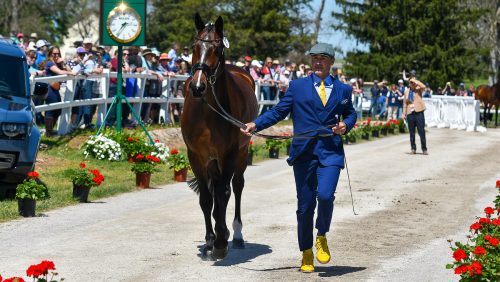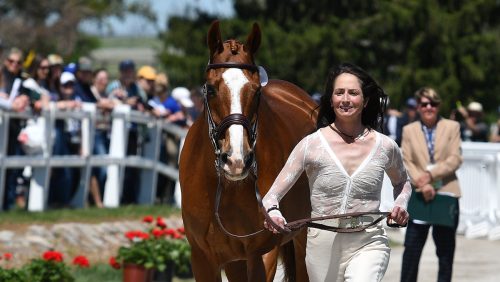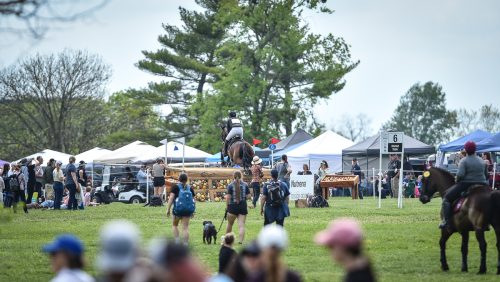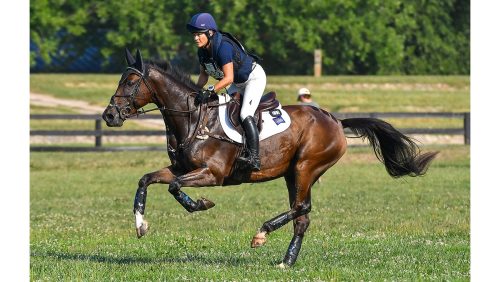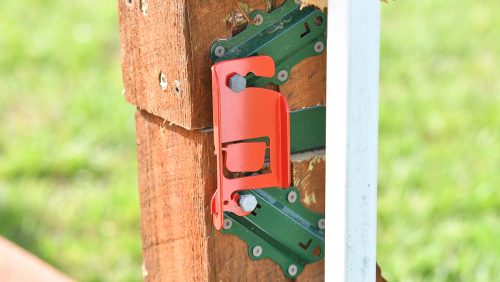Bill of sale: $1. Years of partnership: six. Number of five-star performances prior to the Mars Maryland 5 Star at Fair Hill: zero. Number of five-star cross-country penalties: zero. Tears of joy cried: countless. Value of a horse with heart: priceless.
If 23-year-old Mia Farley had been accurate in her early predictions, she never would’ve competed Phelps, a 10-year-old Thoroughbred owned by David O’Connor, above preliminary. Yet, at the duo’s five-star debut, they not only conquered Ian Stark’s cross-country course, but they also did so as the only double-clear round in an entry list filled with five-star veterans, Olympic medalists and eventing heroes.
Farley, The Plains, Virginia, and Phelps (Tiznow—Boom Town Gal, Cactus Ridge) ended up fifth overall, and their performance thrilled spectators in Elkton, Maryland, and on livestreams around the world with a story that embodies the magic and reward of horses.

“He’s just surprised us a lot,” Farley said. “We’re always like, ‘Oh, I don’t know,’ and then he does it. He’s definitely got the biggest heart of anything I’ve ever had the pleasure of working with, and that can overpower a lot of things.”
A California native, Farley moved across the country to train with the O’Connor Event Team in 2018. She currently works as a rider for the OCET, but she is beginning to branch out and start building her own business.
Is there any truth to the story that David O’Connor bought him for $1?
I’m a little bit unclear on the whole story because it happened before I got here, but I know basically to “make it real,” he was a dollar.
I think Joanie [Morris and O’Connor] had done a Thoroughbred together before, and she asked David if he wanted to take Phelps. He was supposed to be a sales horse, and so Joanie basically told David, “Whenever you sell him, I’ll just take a piece.” Here we are.
What is it like competing a horse owned by an Olympic icon and having him say, “You are the rider to develop this horse”?
It’s definitely a very special and unique experience. David’s obviously my coach and mentor—as an owner as well is pretty interesting. On a lot of other horses, there are times that he’ll be in the warm-up, but I think once it comes to big shows with Phelps, he must be a little bit nervous as an owner. Sometimes he’s not there for a couple of things, but we practice that at home for a reason; we’re ready for it. He’s always been super supportive. Obviously, we’re going to have good shows and bad shows, and he’s never changed his perspective on Phelps and me.
[For most of us,] our parents are our first owners, but as my first non-parental owner, even though basically he’s a dad to me, it’s a very nice experience.
You have described Phelps as an underdog. What do you mean by that?
It’s his whole story. We didn’t actually tell a bunch of people how we got him for a dollar, so just knowing that and bringing him up through the levels. He was going novice, and that was fine. He moved up to training, and that was OK. And then David wanted him to go up to prelim, and personally I was like, “There’s no way.” And so, as an underdog, he’s always just proved everyone wrong. I think David honestly might have been one of the very few people who really saw it in him from the beginning. No one ever thought anything of him until [the Morven Park CCI4*-L (Virginia), where he finished third] last year. I think that’s when I said he was an underdog. That was when we were like, “Wow, Phelps.” He’s always just shown up when he needs to.
ADVERTISEMENT
When you first started working with him, at what level did you think he’d max out?
I thought prelim. I wasn’t too confident in moving up to prelim on him, and then he did it. And I was like, “OK, this is his level.” It was different for me when I first started riding him. I came from a jumper barn in California, so I only ever rode warmbloods that were big moving, big jumping and everything. So, to go on a Thoroughbred after that, it’s a very different feel.
Before the five-star, you took a social media walk down memory lane. What was it like reminiscing over those photos? What stood out when you thought of the whole journey?
David always makes a joke: Six weeks before a five-star, you kind of go crazy for a day. I think one day, looking back on it—all my horses go in pretty small bits, and I for some reason changed everyone’s bit, even though they were all fine. Maybe that was my crazy day.
And then leading up to it, I think the last 10 days before the show, I was like, “Oh my God, I’m about to do a five-star.” Once I got to the show, it was kind of smooth sailing. I just was like, “Well, I’m here.” So, when I looked up those [photos], I just thought it was fun—a five-star has always been my goal. I wanted to do it, but you never actually think you’re going to get there. So, to realize that I was entered in a five- star, it was like, “Wow. I’m going to look back on these fun pictures, when I would look at the big jumps next to the jumps that I was jumping, and I was like, ‘How in the world do these horses or humans do this?’ ”
Tell me about the aftermath of being the only rider to go double-clear on cross-country. You and your team got pretty emotional. Looking back on it, can you articulate those emotions?
He’s such a special cross-country horse. I had one mistake earlier this year on cross-country; it was completely my fault. So that was a little bit nerve-wracking for me, personally. David didn’t mind it. I think he knew it was one show of the multitude that we’ve done that we had a cross-country penalty. But definitely for me going into it, I was like, “If I don’t make a mistake, he’s going to jump around just fine. But if I make a mistake, then that’s on me.”
So once I finished, I was happy to be done with all the jumps, and I had no idea that I actually made [the time]. I knew I was close to time, but I had no idea that I made it until someone said something. Then I just started laughing. I’m the type of person that laughs a lot, so it might be a little bit inappropriate sometimes. [But it was] the whole underdog thing with Phelps. It’s just, he would make time at a five-star, and he would be the only one. That’s why I was like, “Wow, Phelps, you are a character.”
And the fact that it was the first five-star for both of you?
I’d like for it to happen again. Who knows if it will, but that’s why we’ll take in the moment. And Phelps, he would prove to us all that he can do it.
You were pretty much the star of the show at Maryland. What’s it like for you now to receive that kind of attention?
It’s very humbling, honestly. I had no idea that that many people were watching and that that many people are supportive. It was a very cool feeling within the community. And to hear that a lot of people know Phelps and me now, it’s surreal.
Do you have other passions or hobbies that you enjoy when not around horses?
Usually on the offseason, I have babies to break. When I was in California, there was definitely more to do, and I would go to the desert or surfing. But now on the East Coast, it’s very horse-oriented here.
Speaking of breaking, in some of your videos, it looks like you have a unique short longe whip that you use. What is it?
ADVERTISEMENT
The O’Connors did a lot of the groundwork through the Parellis [who teach natural horsemanship]. That thing is called a carrot stick, and it’s a hard, heavy stick. You break [young horses] in rope halters, and you teach them to yield away from the stick. It’s basically an extension of your arm. So then when you’re riding them, instead of having a bit in their mouth and pulling them around, you can steer them with the stick. So, you put it on either side of their head, and they’ll move to the opposite direction. I really like it because it makes it 10 times easier to teach them how to jump. They’re always looking forward, and it’s always forward momentum. Whereas when you put a bit in their mouth, the rider can make a mistake and pull back instead of leading, and then they are not looking at the jump, and it’s a whole snowball effect. But I think it’s a very natural way of doing it.
Since you dabbled in the hunters, jumpers and equitation, what would you say is the biggest misconception the horse show disciplines have about eventers?
Others think eventing is a bit hard on the horse, but you wouldn’t be able to get a horse to do it if they didn’t want to. You see the best horses have their ears pricked the whole time around; it’s very fun, I have to say.
And vice versa?
I think that a lot of people think they don’t care enough for the horses, and I think that’s very wrong. There are different ways of doing everything, and everyone does everything differently.
You experiment with going bridleless, even riding Phelps bridleless. What led you to try that?
That’s another thing we do when we break the babies: We always have a neck rope on them. Along with the carrot stick, you can also teach them to steer with a neck rope. When you yield away from the carrot stick, you can pull the neck rope with the other hand in that direction when you’re trying to get them to yield. Then eventually you can take the carrot stick away, and if you pull the neck rope, they learn to follow the neck rope.
Amy Bowers, who comes and helps us in the wintertime, was like, “Why don’t you ride Phelps in a neck rope?” And I was like, “Good idea!” And she was like, “Well, I was just kidding.” I got on him, and he remembered. He was like, “Oh, yeah.”
It’s so interesting too, the difference. You can go jump Phelps in a neck rope, and he jumps actually a lot better than with a bridle and bit. That tells me I’m doing something that’s blocking his natural way of going. I think that’s what’s really cool. You can kind of go back to how they actually do things to see what you’re doing that’s preventing them.
What’s something people may not know about you?
I’m a pretty open book. I think I’m very approachable. Sometimes I’m walking around, and maybe I look really angry, but I’m actually probably singing in my head. I like to make people happy and laugh if I can.
This article originally appeared in the Nov. 27-Dec. 11, 2023, issue of The Chronicle of the Horse. You can subscribe and get online access to a digital version and then enjoy a year of The Chronicle of the Horse and our lifestyle publication, Untacked. If you’re just following COTH online, you’re missing so much great unique content. Each print issue of the Chronicle is full of in-depth competition news, fascinating features, probing looks at issues within the sports of hunter/jumper, eventing and dressage, and stunning photography.






